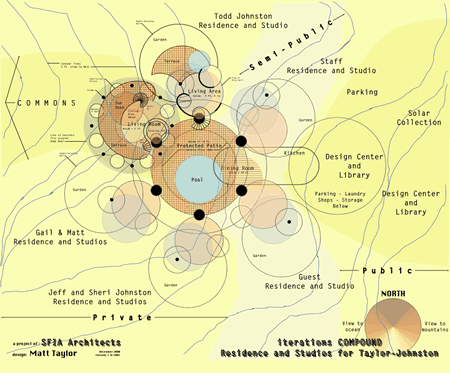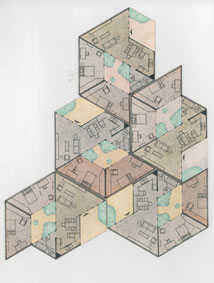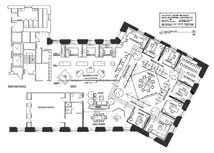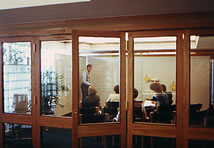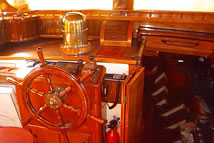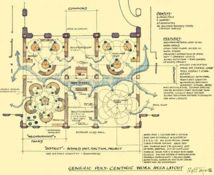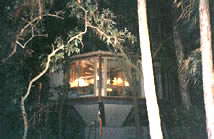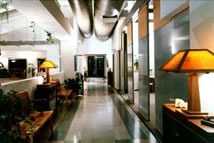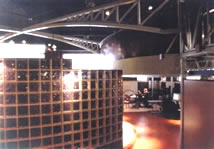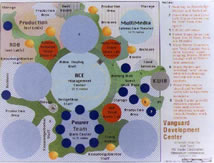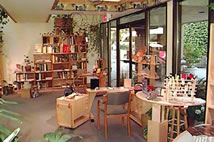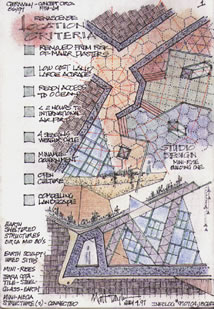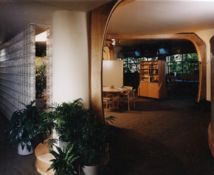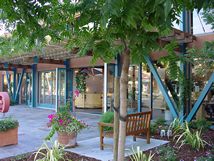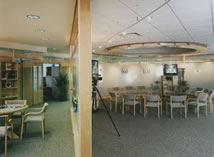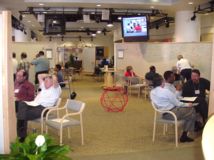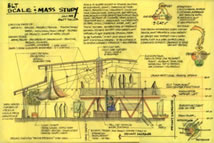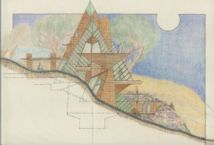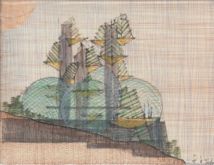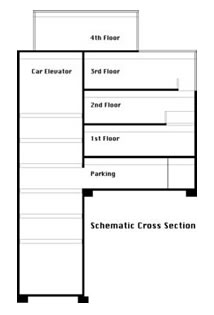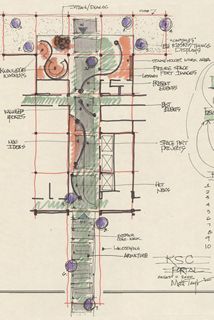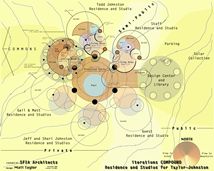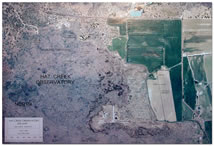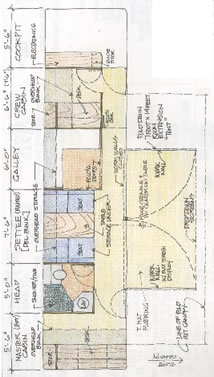|
In mid 1979, Gail and I left Kansas City and moved to Boulder,
Colorado via a summer in Washington DC. The plan was not
to go to Boulder but to California to build a retreat center
(Work #64). This project fell through at the very
last minute. I designed my first environment explicitly
intended for a new way of working that summer in DC (Work
#65) - this project also fell through. It was then
that Gail and I moved to Boulder and started what is now
MG Taylor Corporation. Our first environment was built in
1980 (Work #73).
|
|
Work 64
1979
- Retreat Center
|
|
Client:
Work:
Design:
Location:
Status:
Notes:
|
Ca
De
Matt
Taylor
St.
Not Built
A 1
|
|
Work 65
1979
- Management Center for Barbara Hubbard
|
|
Client:
Work:
Design:
Location:
Status:
Notes:
|
Barbara
Hubbard
Design, Build, Operate
Matt
Taylor
Greystone Mansion, Washington DC.
Not built
The first Management Center design. This project
was to convert the garage of Barbara’s Mansion into
a collaborative work space to support her many futurist
activities. The large WorkWalls, real time video and computer
documentation system were a part of this design. It was
based on a way of working. I had been thinking of this “method”
for a couple of years. This design was the first expression
of it.
|
|
|
Work 66
1979
- Taylor Residence
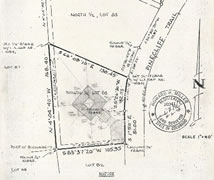
Client:
Work:
Designer:
Location:
Status:
Notes:
|
Residence
for Gail and Matt Taylor, Boulder #1
Design - Build - Use
Matt Taylor
Boulder, Colorado - Nederland
Not Built
A simplified and more rustic version of the Steinmeyer
House (#46) resting on four wood columns that form the center
core of the structure. Roof and all floors cantilever from
this center element. The Carport is a bridge from the road
grade level - all structure is free from the sloping site.
A greenhouse sits on the lower section of the site and connects
at the first deck level. Materials and details were selected
to utilize local skill levels. |
|
|
Work 67
1979
- Taylor Residence
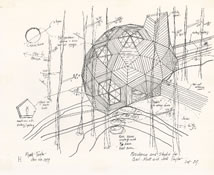
Client:
Work:
Designer:
Location:
Status:
Notes: |
Residence
for Gail and Matt Taylor, Boulder #2
Design - Build - Use
Matt Taylor
Boulder, Colorado - Nederland
Not Built
A fully equipped living and work environment with shop
and labs. The interior space was conceived as a series of
semicircular, partially overlapping platforms
that provided a large variety of accommodations. Materials
and details were selected to utilize local skill levels. |
|
|
Work 68
1979
- Snowflake Rooftop
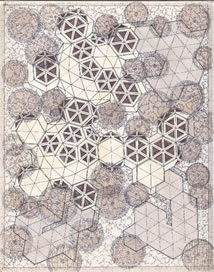
Client:
Work:
Designer:
Location:
Status:
Notes: |
Project
Design
Matt Taylor
Boulder, Colorado
Concept
If you think of it, every roof top represents the land
below the building. Cities have acres of flat roof tops that
are ugly and not used. Light weight structures, patios and
landscaping can turn these wasted resources into useful gardens.
Mixed use can bring back community and urban density (in Jane
jacobs terms). This project proposed to do this using the
Snowflake configuration of the Fuller “Hexipent”
geodesic dome. |
|
|
Work 69
1980
- Snowflake Office
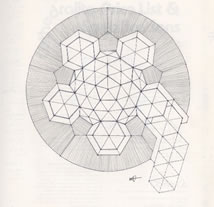
Client:
Work:
Designer:
Location:
Status:
Notes:
|
Project
Design
Matt Taylor
Boulder, Colorado - Nederland
Concept
Land is often compromised in the development process.
Generally, it becomes more valuable and then existing structures
are “overbuilt.” Here, the Snowflake configuration
is employed to create a “temporary” movable structure
that requires little in the way of site development. When
it is time, Snowflake is refurbished and moved to another
site to start the cycle again. |
|
|
Work 70
1980
- Tree City Concept
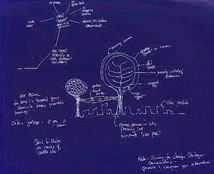
Client:
Work:
Designer:
Location:
Status:
Notes:
|
Project
Design
Matt Taylor
Boulder, Colorado - Urban center
Concept
How do you build an intentional Mega City out
of an non-intentional “flat” Mega City (which is
what our urban centers are) without disrupting the existing
“city” through the transition? Glenn Small pointed
the way with his work in the 1970s. My version of “building
over” takes advantage of mass produced, light weight
geodesic structural components. These treelike structures
can be built “out” of parks and parking lots and
span over the existing structures. The existing foot print
is not greatly effected. Horizontal “bridges” bring
lateral stability and provides a growing technical armature.
The old city dissolves, naturally, as the new city evolves
which was Glenn’s original insight. A version of this
was proposed for the Affordable Housing project - Work #71. |
|
|
Client:
Work:
Design:
Location:
Status:
Notes:
|
City
of Boulder
Design Concept and facilitate consortium
Matt
Taylor and Langdon Morris
Boulder, Colorado
Design not built - consortium executed a project
This was our first contract in Boulder which ended
with the first DesignShop process we did in our new environment
(Work #73).
The
project that we designed was a small subdivision of adjustable
components inside a multi-acre “greenhouse.” This
proved to be a bit much for the city fathers and the public/private
consortia that was assembled to implement the project. A
project that did get build grew out of the consortia, however,
and some of the ideas that drove the first design found
their way into the project as much as this was possible
given the more conventional approach. The consortia was
very successful which was the big gain from the DesignShop
event.
The
first design, itself,still intrigues me and incorporated
several innovations that have yet to be proposed anywhere
that I am aware of. The basic concept was to build a giant
greenhouse and a cluster
housing grid within it. A light weight, movable system
could then be used to assemble different living units as
each family group required - and easily change, as requirements
changed. A certain percentage of the footprint would always
be dedicated to landscape and gardens - a commons - between
units and within each unit. Parking and mechanical systems
would be under the building. This concept accomplished considerable
land utilization with a sense of urban oneness and
the freedom of country living. Radical. The scale and scope
of the AI armature
systems of today is almost “up to” this task
considered “impossible” 21 years ago.
With
modern means and materials, this concept can be executed
today on an economical basis.
|
|
|
Work 72
1980
- Instead
Studio and Residence for two Families
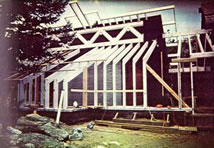
Client:
Work:
Designer:
Location:
Status:
Notes:
|
Matt
and Gail Taylor
Design - Build - Use
Matt Taylor
Boulder, Colorado - Nederland
Sold by Acacia - Finished Without Supervision
This addition was built on wood footings and featured
double shell construction. It incorporated, heat sink, greenhouse,
hot tub, wood stove and mass storage into a single energy
management system. |
|
|
Work 73
1980
- Anticipatory
Management Center
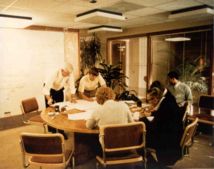
Client:
Work:
Designer:
Location:
Status:
Notes: |
Taylor
Associates (now MGT)
Design - Build - Use
Matt Taylor
Boulder, Colorado
Operated 1980 - 1983
This was a 10 day remodel of an existing space. We
built a WorkWall system using solid core doors with the work
surfaces applied where desired. A carpet base covered the
modular runner that held the walls. Clips attached to the
hung ceiling “Ts” held the top of the walls. All
was trimmed out to match the existing building trim which
was well done. The WorkWalls defined the various spaces -
no doors were used. At lease end, the entire system was removed
in a day leaving no damage to the building. |
|
|
Work 74
1981
- Laura Powers Residence and Studio
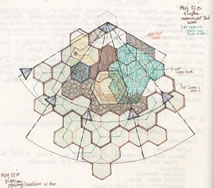
Client:
Work:
Designer:
Location:
Status:
Notes:
|
Laura
Powers
Design - Build
Matt Taylor
Boulder, Colorado
Not Built
An earth-sheltered two level house in a forest clearing.
A triangular wood laminated column and beam system also housed
utilities and lights. This project was an early “EarthShip.” |
|
|
Work 75
1982
- CyberCon System Environment
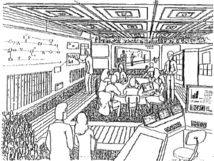
|
Client:
Work:
Design:
Location:
Status:
Notes:
|
Taylor
Associates (now MGT)
Design
Matt Taylor (Jim Toohey, drawing)
Boulder, Colorado
Concept Sketch for Annual Report
Not an architectural space concept but rather a visualization
of the technology augmentation system. Wireless PDAs, Laptops
working with CyberCon hardware/software and electronic walls
supporting Group Genius locally and with “Remote Presence.”
This work explores the application of cybernetic tooling to
the human work processes IN the formal physical workplace.
What is shown here is just coming about 20 years later. The
work tools are just becoming available and the old work habits
- built on 19th Century concepts and amplified with 20th Century
technology - are beginning to die. Still, any significant
integration is rare. The technology has to be ubiquitous and
seamless - it cannot dominate. Natural human processes have
to be amplifies and extended OUT into the larger world.
The physical sense of space and presence must not be lost. |
|
Work 76
1982
- Conference Center
|
|
Client:
Work:
Design:
Location:
Status:
Notes:
|
Jack
Design and facilitate design/build team.
Matt
Taylor
Boulder, Colorado
Not built
This was my first experience of a project that became
dominated by the
in-place real estate development model (outside of design/build
developers) with all the ins and out s of feasibility studies
by large accounting firms and so on. I was appalled. I saw
a project destroyed and a small developer picked clean by
the big time consulting professionals.
|
|
|
Work 77
1983
- RDS System
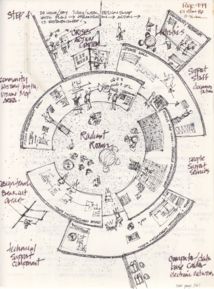
Client:
Work:
Designer:
Location:
Status:
Notes:
|
Taylor
Associates (now MGT)
Design - Build - Use
Matt Taylor
Boulder, Colorado - Mobile
First deployment 1983, ongoing since 1995
The RDS has been employed by MG Taylor and CGEY to
serve business clients all over the world. A “complete”
working environment out of a truck. As yet, the social purpose
of the RDS has not been employed. The idea, however, of portable
environments is well tested. |
|
|
Work 78
1983
- PDPM Center
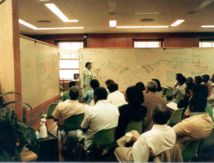
|
Client:
Work:
Design:
Location:
Status:
Notes:
|
Acacia
Mutual Life
Design - Build - Use
Matt Taylor & Jim Toohey
Washington DC
Operated 1983 through 1986; removed 1992
Built in an old Masonic Room on the 7th floor in the Acacia
Building across from the US Congress. The room was solid teak.
The Management Center was a “room within a room”
without one nail into the existing structure. |
|
|
Work 79
1983
- Acacia
Management Center
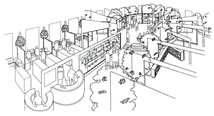
|
Client:
Work:
Design:
Location:
Status:
Notes:
|
Acacia
Mutual Life
Design
Matt Taylor & Jim Toohey, design lead
Washington DC
Not Built
To be built on the second floor off the main lobby
of the Acacia Building this would have been a full expression
of our “executive” augmentation system. |
|
Work 80
1985
- Acacia Executive Suites
|
|
Client:
Work:
Design:
Location:
Status:
Notes:
|
Acacia
Mutual Life
Design
Matt Taylor & Jim Toohey, design lead
Washington DC
Not built
This was a navigation center with individual work
spaces for an executive team and their support staffs. The
collaborative work area is in the center with individual
work areas and small team areas around the parameter. Work
#93 followed this general schema. The CEO’s
office (in the lower lh corner) was to be kept intact to
be used by any member of the senior staff for ceremonial
functions as appropriate.
|
|
|
Work 81
1985
- Orlando
Management Center
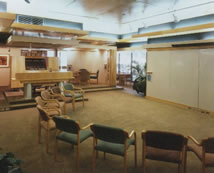
|
Client:
Work:
Design:
Location:
Status:
Notes:
|
Acacia Mutual Life
Design - Build - Use
Matt Taylor & Jim Toohey, design lead
Washington DC - Orlando Florida
In operation by Third Owner
This environment was built as the direct expression of a business
model that we both co-designed and facilitated the development
process that produced it. It was, at the time, the most specific
and intimate fit of an environment to newly designed work
processes that we had ever produced. It was, also, the most
complete environment we had done in terms of the integration
of and full expression of our 1982 environment, work process,
technology augmentation
Model (see Work #75). It was, also, by far the
most expensive work per square foot we had ever produced.
However, over 15 years later having been through 3 lease cycles
without extensive redoing, the space proved to be very economical
indeed. The flexibility inherent in the design allowed the
space to be used by very divergent companies without modification.
The quality mostly natural materials lasted long beyond the
typical cheep materials despite heavy use and three lease
cycles. The space accommodated the many work modes of the
modern organization. |
|
Work
82
1987 - Capital
Holding Design Center
|
|
Client:
Work:
Design:
Location:
Status:
Notes:
|
Capital Holding Corporation
Design-Build-Use
Matt Taylor
Orlando,
Florida - Louisville, KY
Operated
1997 to 1992 - Demolished when building replaced with new home office campus
This was an interesting project because the space was
considered totally inadequate for the purpose. It was, however,
the only space available until a new building could be built
(Works #84 & #87). The program was difficult
because the end result had to function as a conventional corporate
training center and a fully functional Taylor-style
navCenter - all in a little over 3,000 chopped up
square feet. Flexibility in this environment was very great
and arrived at in an subtle way. Each space was fairly constrained
by structural elements yet organized to do several different
functions depending how the furniture (mostly built-in) was
deployed. The overall layout was divided into three zones
that allowed extensive multitasking with different groups.
The space supported training, collaborative design and individual
work. |
|
|
Client:
Work:
Design:
Location:
Status:
Notes:
|
Gail
and matt Taylor
Design - Build - Use
H. Angelman; Armour Rice, Gail & Matt Taylor
St. Augustine, Florida - Mobile
In Use
Camelot is total architecture. She requires a level
of integration that view land-based structures achieve.
|
|
Work 84
1990 - Office Landscape
|
|
Client:
Work:
Design:
Location:
Status:
Notes:
|
Capital
Holding Corporation
Design - Build - Use
Matt Taylor
St. Augustine, Florida - Louisville, KY
Not Built
This layout demonstrated that it is possible to get the
workplace density required by modern economics AND
more space per knowledge worker WITH a user controlled
flexible layout. It took nearly 12 years, from the time
of this sketch, to develop the WorkFurniture components
and secure a Patent on this system. This layout was originally
drawn to demonstrate an office landscape approach for the
new Agency Group office building in Louisville, Kentucky
but a conventional open office layout system was used instead.
We did do the Management Center portion of the building
on the first floor (Work #87). This sketch, along
with Work #75, have become the basis for the Armature,
WorkPod and CubeOffice systems - now the AI Foundation 2
Series product line.
|
|
Work 85
1991
- Studio and Residence for Gail and Matt Taylor
|
|
Client:
Work:
Design:
Location:
Status:
Notes:
|
Gail
and Matt Taylor
Design - Build - use
Treetop Homes 1967; Matt Taylor remodel 1991
Hilton Head SC
Sold 2000
Treetop Homes has built the Sealofts for more than
35 years. This one was part of a development of 73 on Deer
Island a part of Hilton Head. Unfortunately, the Sealofts
were divided up into pie shaped rooms with a furred area
in the center to house a noisy air conditioner. We opened
the space up, put the HVAC in the storage area below and
cleaned up the details. The character of the environment
instantly changed. Gail and I lived in the Sealoft for nearly
10 years until we relocated to the West coast and sold it
to on of our associates. For the first 5 years, it also
served as the home office of MG Taylor Corporation. It was
a compact environment - 800 square feet - on the intersection
of a march and a forest, 5 minutes walk from Harbour Town
one of the most active resorts on the east Coast. Our total
cost, purchase and remodeling was less than $130,000!
|
|
Work 86
1991
- AEDC Gossick Leadership Center
|
|
Client:
Work:
Design:
Location:
Status:
Notes:
|
US
Airforce
Design - Build - use
Matt Taylor and Jerry Headly
Hilton Head SC - Tullihoma, Tenessee
In Operation
A 8,000 square foot space to support the DesignShop
process. An old NCO club was extensively redesigned. 40
Design Shop events were held in the first year for the USAF,
NASA and the aerospace industry. The facility sit on a human-made
lake that is used as cooling water for the testing facilities.
This provides ambiance for working retreats just a few miles
from the Base. This Center won a USAF award and became the
place where many Airforce and aerospace innovations took
place in the 90s.
|
|
|
Client:
Work:
Design:
Location:
Status:
Notes:
|
Capital
Holding Corporation
Design - Build - use
Matt Taylor
and Donny Weber - Weber and Weber
St. Augustine, Florida - Louisville, KY
Sold and Destroyed
A 11,000 square foot Management Center built on two
levels accomplished by lowering the first floor slab four
feet. A knowledge worker deck was suspended above the main
work area which enjoyed high ceilings of varying height.
A steel Armature system delivered power, phone, LAN and
multimedia to 150 nodes throughout the space.
|
|
|
Client:
Work:
Design:
Location:
Status:
Notes:
|
Vanguard
Corporation
Design - Build - Use
Matt Taylor
Hilton Head SC - Pennsylvania
Not Built
As a concept, it fully employs the Pod and Armature
system to an extent that has not yet been built. It is also,
as yet, the only NavCenter that has been conceived as a
dedicated rapid-prototying and project incubation
environment.
|
|
Work 89
1996
- Hilton Head knOwhere Store
|
|
Client:
Work:
Design:
Location:
Status:
Notes:
|
MG
Taylor Corporation - knOwhere Stores
Design Build Use
Matt
Taylor
Hilton Head, SC
Operated by knOwhere 1996 - 2001
This space was created between Christmas 1995 and
January 4th 1996 and upgraded, over a ten day period, the
following May. It was from this environment that the EY
relationship and transfer was designed. The Store operated
until the summer of 2001.
|
|
Work 90
1997
- Renascence III
|
|
Client:
Work:
Design:
Location:
Status:
Notes:
|
Matt
Taylor
Study
Matt Taylor
Hilton Head SC
Study for future Project; See Powers residence project
#69 for an early expression of this idea. I have
played with this concept on and off since the late 50s.
It is an Earth-sheltered residence with a lightweight column
and joist system that allows a structurally independent,
variegated window wall system. This project employes the
muti-module system which is the same for the Bay Area Studio
project (#96).
|
|
|
Client:
Work:
Design:
Location:
Status:
Notes:
|
MG
Tatylor Corporation and knOwhere Stores
Design-Build-Use
Matt Taylor & Inga Hanks
Hilton Head SC - Boston, MA
Sold to CGEY 1998 to be used for their ASE DesignShop
Events, this environment was built in 30 days over the 1996
Christmas holiday period. It was a remodel of an old jam
factory building. The 20 foot by 20 foot spacing of the
columns presented an interesting challenge given the size
of the groups that had to be accommodated. An integrated
video feedback system dealt with the sight line issues.
As a place to do the DesignShop process, this has been the
most productive environment we have ever built. It is also
recognized as one of the most comfortable in support of
long, intensive, multi-day, large-group work-processes.
The wood arches act as an armature visually integrating
the center bay-to-bay areas, formed by the concrete columns,
and housing electrical, LAN and a/v lines. Within this 20
foot by 20 foot grid nearly everything is flexible. WorkWalls
fold out from the exterior columns other WorkWalls, workstations,
storage units and book cases roll into place - providing
utility and creating defined work spaces for a wide variety
of uses.
|
|
|
Client:
Work:
Design:
Location:
Status:
Notes:
|
MG
Tatylor Corporation and knOwhere Stores
Design-Build-Use
Matt Taylor with John Norway and Inga Hanks
Hilton Head SC - Palo Alto CA
Operated by knOwhere, Incorporated
The most extensive modification to the existing structure
of any of the Management, NavCenter or knOwhere Stores.
Because of this and because of the ambiance of the Palo
Alto weather, a fuller integration was possible between
inside and outside than with past built projects. This is
only a beginning, however. As of yet (mid 2001) the full
potential of the designed-in inside/outside opportunity
is not being fully employed. The USE aspect of this
project lags behind the concept and it’s implememntation
(so far, about 50% completion). Although there is a great
deal of physical “architecture” yet to finish
with this project, the greatest challenge will be to fully
employ it. Design, Build, Use. The PA knOwhere Store
is the main LAB of the MG Taylor - knOwhere enterprises.
The building was designed to evolve with both the business
of knOwhere and the community of which it is a part. As
the shopping district changes so will the character of knOwhere’s
walk in business. Progressively, the building will open
up to the street as it was designed to do. The a/v integration
and capability will become greater. The uses will expand.
Today, the knOwhere store houses retail, group process areas,
display areas, office hoteling, business incubation and
a great deal of infrastructure: iSP services, audio/visual
capture, display and editing and printing capability.
|
|
|
Client:
Work:
Design:
Location:
Status:
Notes:
|
Continium
Health care
Design-Build-Use
Matt Taylor and Inga Hanks
Hilton Head SC - NY, NY
Operated by CHC
This design is related to the Orlando Management Center
(Work #81) grammmer with a significant difference.The
OMC, built in 1985, was completely custom work. The Continium
NavCenter is built from system - from manufactured goods.
It took 13 years to get to this point
|
|
|
Client:
Work:
Design:
Location:
Status:
Notes:
|
Detroit
Edison
Design-Build-Use
Matt Taylor and Jim Lucky
Hilton Head SC - Detroit, Michigan
Operated by Detroit Edison
|
|
Work 95
2000
- Executive Office Landscape
|
|
Client:
Work:
Design:
Location:
Status:
Notes:
|
Herman
Miller Corporation
Rework of project Under Construction
Matt Taylor with Bill Stumpf
Hilton Head SC - Holland, Michigan
Not Built per this Concept
|
|
Work 96
2000
- Studio
for Matt Taylor
|
|
Client:
Work:
Design:
Location:
Status:
Notes:
|
Matt
Taylor
Design-Build-Use
Matt Taylor
Palo Alto, CA
In Design Development
This is a strictly personal project. The environment
for my future practice of architecture. The original projected
build date was 2002. This may prove optimistic for reasons
of finance. Maybe not, however. It depends on the growth
of MG Taylor and my “exit” strategy. The financial
idea is that the building is built cash and has an “annuity”
to cover all maintenance and expenses. It is an instrument
of architectural practice in several ways: first, it is
a signature project - and example of the work I can do;
second, it is a place to work - the knowledge factory to
produce the work; third, it is a “homestead” that
provides the basic necessities of living making the financial
aspects of building a practice much easier. Total architecture
in effect. In this regard, an extremely intimate
work. The scale of the work is also Intimate. The building
is designed, in this regard, to be more like a boat than
a typical land structure. The Studio is a development of
a concept I developed in New York in the early 60s (#20).
|
|
|
Client:
Work:
Design:
Location:
Status:
Notes:
|
HP
Star Team
Design-Build-Use
Matt Taylor
Palo Alto, CA - England
Project Dormant
I suppose that when I build this one to the full
extent of the concept’s potential I will consider that
I have achieved a big piece of what I set out to do in architecture.
This project still gets me up in the morning. Someday, I
will get it done. This work was inspired by the Coleridge
poem and was not put on paper for over 40 years. I had the
architectural idea before the client or the application.
This application is for a self contained innovation center
to be built in a remote landscape. The public and collaborative
functions take place in the 5 domes and personal and sleeping
facilities are provided in the towers. Clusters of small
towers are sprinkled throughout the landscape for additional
guests, contractors and staff. Each of the “apartment”
units are about the size of the Bay Area Studio project
(#96). There is not a building on the planet that
has the variety of spaces that Xanadu does nor is there
one that can accommodate a greater range of human creative
experience.
|
|
|
Client:
Work:
Design:
Location:
Status:
Notes:
|
Christopher
Allen
Design Build Use
Matt
Taylor
Palo Alto, CA - Berkeley Ca.
In Design Development
This project is the prototype of a new building type. It
is the equivalent of what the Usonian House did for residential
design. This is a rethinking of the the small office buildings
in a traditional medium-density urban setting. As such,
it has the ability to adapt to a large number of cities
in the USIt is composed of flexible interior and exterior
components so that the specific layout of the office spaces
and reflect the exact needs of various tenants as they change
over time without the need for remodeling. I first envisioned
this kind of flexible layout for a residential project in
1956 - See Work # 4.
|
|
|
Client:
Work:
Design:
Location:
Status:
Notes:
|
Kennedy
Space Center
Design
Matt Taylor
Palo Alto, CA - Cape Canaveral
Projects dormant
An interesting challenge.
|
|
|
Client:
Work:
Design:
Location:
Status:
Notes:
|
Confidential
(at this time)
Design community developmenet system
Matt
Taylor and MG Taylor Corporation
Palo Alto - Baltimore
In Design Development/Grant application
This is the complete end-to-end redevelopment process.
The Master
Planning Process (Work #37) will be employed
by a community-based NavCenter that will also do for-profit
corporate work.
|
|
|
Client:
Work:
Design:
Location:
Status:
Notes:
|
Matt
& Gail Taylor, Jeff, Sheri & Todd Johnston
Design-Build-Use
Matt Taylor
Palo Alto, CA
Schematic design
An extended family and family business compound designed
as an alternative to modern suburban living patterns. This
is a reworking of the Cooper house (Work #17) concept
employing adobe, as well as, gunite and precast concrete.
The iterations complex is a co-housing, multi-generational
family work and living environment for a northern California
site designed to over look the ocean from high bluffs. iterations
is the IP and social entreprenuering entity of gail and
myself and our sons Todd and Jeff. The is the “business”
that we will run when we are financially retired from business.
Earnings from our MG Taylor company investments will flow
into iterations and from this environment we will do the
projects that spurred us to develop MG Taylor in the first
place. This may - or not - be the predominate living environment
of any of us. It is proposed (by me) to be where we will
“live” and have guests - and work - when we do
the family business. My archictural work, for example, will
be carried out from another place (Work #96).
|
|
Work 102
2001
- Roe Project
|
|
Client:
Work:
Design:
Location:
Status:
Notes:
|
Roe
Design - Project Management
Matt
Taylor
Palo Alto, CA - Seol Korea
Program
proposal - (password required)
A large office building in Korea for a major wireless
corporation. Three tasks make up this project: first, a
better concept of the project in it’s totality; second.
Employing a NavCenter to facilitate the meta-design, the
design/build team and the integration of the environment
to the corporation’s activities; third, a specific
design for the the building’s public spaces and office
areas. The challenge is to find an architectural grammar
and expression that is a synthesis between traditional Korean
art and architecture and the appropriate expression of a
21st Century corporation with international expectations.
|
|
|
Client:
Work:
Design:
Location:
Status:
Notes:
|
Study
Design
Matt
Taylor
Palo Alto, CA - Northern California
Concept development
|
|
|
Client:
Work:
Design:
Location:
Status:
Notes:
|
SETI
Design,/Facilitate
Matt Taylor
Palo Alto - Hat Creek
Program Development
An iteresting challenge: a Visiter Center in a remote
part of Northern California.
|
|
Work 105
2001
- Mobile Unit #1
|
|
Client:
Work:
Design:
Location:
Status:
Notes:
|
Matt
Taylor
Design Build Use
Matt Taylor
Palo Alto - Mobile
Concept Development
This
will be the first iteration of the mobile unit component
of my Bay
Area Studio (Work #96). It will be built on a
traditional bus platform and be finished much like a cross
between a boat and a traditional Japanese house - a “land
yacht.” It is designed to support both my architectural
work and my MG Taylor work. This iteration will be powered
by diesel set up to run on soy fuel (and any mixture of
vegetable oil and petroleum). Solar cells will augment the
diesel generator. The main living area exterior wall folds
down to make to a tent covered multipurpose area. WorkWalls
(which face inward when closed) fold out to make the sides
of the room. This multipurpose area is suspended by diagonal
cables so the the entire area is cantilevered. This way
only the bus needs to leveled and the slope under the multipurpose
area is immaterial to stability.
|
|
Work 106
2001
- Interactive Learning Environment
|
|
Client:
Work:
Design:
Location:
Status:
Notes:
|
Mendoza
College of business
Design, Build, Use
Matt
Taylor
Palo Alto -
Program development
This is the design for an interactive learning environment
of a major American business school. This is a just under
10,000 square foot space in the basement of the college’s
building. This means we have to get natural light and ventilation
into the environment. The drawing green areas are landscapes
that are feed by light tubes (in two cases) and Light wells
with opening glass skylights. The basic concrete superstructure
other than the light wells will be left almost entirely
as is. A full Armature
System will be employed which will define the spaces
and provide all wire chases. A step down from that will
be light weight moving screens that can define even smaller
spaces and provide texture and color to the environment.
Then, the WorkWalls and then the individual pieces. Other
than the Armature, the landscape areas and the one storage
area the only ”fixed” item is the multimedia and
interaction pit in the center. This create a highly flexible
place with the vast majority of the budget going for item
that can be easily moved if the space needs to be put to
a new use.
|
|
|
1979
to mid 2001 produced 41 projects in 22 years 15 of which
were built with eight more in active development.
|
|
Clearly
this period, 1979 to 2001, is the FOCUS period and
platform for moving to ACT. What makes this so? It
is the maturity of the market place and the beginning acceptance
of the the design, build use process. It is the fact that
ALL of the various architectural ideas that I have
explored are beginning to find there way into a single integrated
approach.
|
|
Part
3 of this chronology documents
my full “return” to architectural practice as
my primary work effort. This practice
model will be made of three aspects: Large-scale (globally
distributed) projects in collaboration with a ValueWeb of
“cathedral
builders;” distributed “publishing” of
buildable plans and specifications coupled with an interactive
design, build use information service with a focus on low
cost, self-sustaining solutions; and, the design and building
(and most probably, operating) of cutting edge prototypes
that push the state of the art and constitute the highest
level of architectural ART.
|
|
It
is my goal to be involved in hundreds of large-scale projects,
to publish plans that will be executed in the thousands
and to complete over the next 20 years a few hundred art
pieces as examples of my philosophy and craft in the “purest”
form. All of this work will be done in context of the Master
Planning process (see # 37).
These three seeminly different practice strategies actually
make one integrated approach to architecture and meet the
social, legal requirements of all the major categories of
work. Large-scale projects have, by their nature, certain
financial and complexity aspects that require a large consortia
of design/build professionals. The mass housing and small
office market another set of conditions and constraints.
“ART” pieces are produced for “patrons”
and provide the opportunity to explore the outer dimensions
of architecture. It is a major way how R&D in architecture
is done. The three together make a whole practice.
|
| This
is, perhaps, somewhat arbitrary but I choose to cut this phase
off with Work #106 and mid June 2001 (the end of my
44th year of practice). My sense is that future projects will
stem both from the work of the last 20 plus years (Management
and NavCenters, and so on) and also from an entirely new perspective.
This new source of design work will be, in effect, my “return”
to a “pure” practice of architecture. |
•
Part 1
of 3 •
Part 1a
of 3 • Part
3 of 3 •
Narrative
•
|
Matt
Taylor
Palo Alto
March 24, 2001

SolutionBox
voice of this document:
VISION • STRATEGY • EVALUATION
posted:
March 24, 2001
revised:
October ß22, 2001
•
20010324.242345.mt • 20010407.21124356.mt
• 20010407.778932.mt •
•
20010408.663981.mt •
20010503.229984.mt • 20010413.776120.mt •
• 20010517.999923.mt •
20010526.398877.mt • 20010612.457211.mt •
• 20010625.547612.mt •
20011022.333390.mt • 20011115.292871.mt •
(note:
this document is about 50% finished)
Matt
Taylor 650 814 1192
me@matttaylor.com
Copyright©
Matt Taylor 1979, 1980, 1981, 1982, 1983, 1985, 1988, 1990, 1991, 1995,
1998, 1999, 2000, 2001
|

